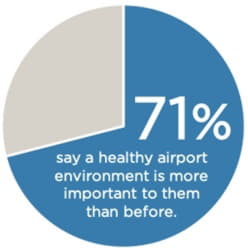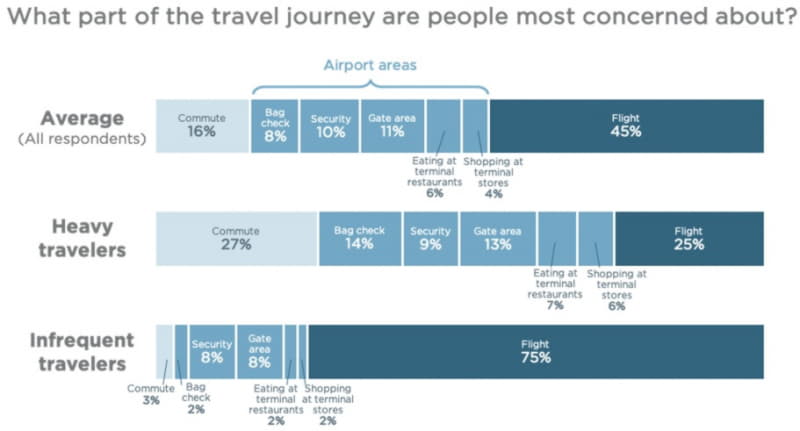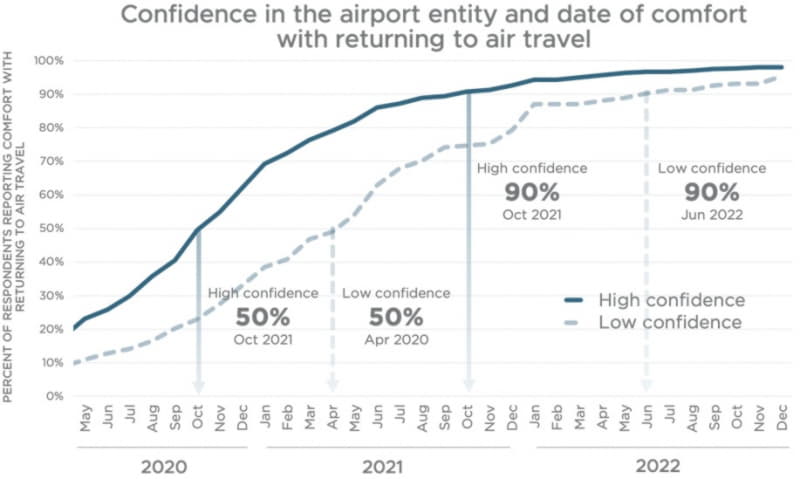Americans want to fly again. For frequent travelers,it’s the airport, not the flight, that is concerning.

Folks want to fly again. Frequent travelers, both personal and business, even more so.But fora speedy return, airports need to restore passenger confidence of the airport as a safe and healthy environment.Although pent up passenger demand is evident, personal health and the health of others is a top priority for passengers in the future. When asked about their heightened concern regarding health during travel, 71% said it was a greater priority than just 4 months ago.
So, what are travelers concerned about? Interestingly, we found that people’s concerns depend on how frequently they travel. The most frequent travelers (more than 5 flights/month for business or personal reasons) rated the activities at the airport as their highest area of concern (49%), much more than the flight itself (25%).On the other hand,infrequent travelers (less than 1 flight per month)were completely different, with the flight by far and away their top concern (75%).

Airport design and policies can be powerful tools to restore traveler confidence.While news headlines often focus on full airplane flights a top barrier to travel, the survey finds that the airport environment isthe frequent traveler’smain worry, outweighing both the ground commute and the airplane flight. Their perception of risk centers on three key areas: baggage check, security, and the gate area. The passenger experiencemust be modified and improved for each of those areas through updated airport design and operations.
The first step to restoring confidence is to understand and address passenger needs in a COVID world. Social distancing, touchless technology,and environmental monitoring top the list as must haves for future travelers. These must be implemented from the curbside to the boarding gate and everywhere in between.
1) Entry point screening is a critical first step. At the airport,travelers want visual clues that smart procedures are being implemented to limit the spread of COVID. Passengers will be greeted at the curbside and other airport entry points with a touchless kiosk to monitor health and secure entry. A questionnaire and temperature checks will be performed in a seamless manner to minimize queuing and prevent potential disease spread. Ideally this is all integrated with the traveler’s airline app, providing a more seamless passenger experience and integrated contact tracing functionality.
2) Ticketing, bag check and security are touchless, rapid and designed to maintain social distancing. With, or even without entry point screening, packed queues for bag check, dense, high-touch TSA security and gate mobbing are notable stress points with frequent travelers in this ‘living with COVID’ world. Redesigning layouts and queuing strategies combined with leveraging new touchless technologies, can speed up processing, minimize the wait and keep everyone at safe distances.
3) Post-security, passengers need to move freely with confidence. Following the screening processes pre-security, passengers want to return to their comfortable shopping, dining and waiting habits in a safe environment. To do that, the post-security terminal spaces need to communicate the policies and conditions that restore confidence. The research shows that 86% of frequent travelers feel that real-time display of environmental conditions at the gate would ease their mind. Best-in-class airport designs deliversafe and clean air via a multi-tiered filtration process, but design and technology need to be in place to clearly deliver the message to every passenger. Surfaces need to be cleaned regularly and when possible, continuously monitored with technology.
Restoring passenger confidence is not an academic exercise. Confidence in airport health policies can accelerate the rate of US passenger travel by up to 8 months.

Confident passengers reported that they would return to travel sooner. Just 20% of travelers said they were currently comfortable traveling. With increased confidence in the airport, that number increases to 50% in October of 2020, butwithout confidence, passengers won’t reach the 50% milestone until April of 2021. The contrast is more dramatic to reach 90% of people comfortable traveling again, with dates of October 2021 for those with confidence in the airport versus June 2022 for those without. Changes to the design and operation of airports are critical to the recovery and future profitability of the aviation sector.
Method: Gensler, a global design firm, and View, a smart glass company, collaborated on a research project to understand passenger attitudes toward future travel and to make informed recommendations on how to rebuild trust in the aviation industry through design. The survey of 970 people across the U.S. was conducted online via an anonymous survey on May 14th, 2020. The respondents were representative of the general traveling public.


